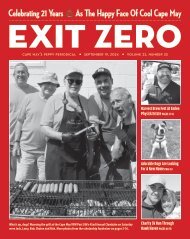V19 N34
September 30, 2021 V19 N34
September 30, 2021
V19 N34
You also want an ePaper? Increase the reach of your titles
YUMPU automatically turns print PDFs into web optimized ePapers that Google loves.
Bird Droppings<br />
Dispatches from the nation’s birdwatching capital… by Seymore Thanu<br />
When Blackpoll Warblers begin<br />
turning up in Cape May, you<br />
know fall warbler migration<br />
is nearing its finale. Breeding<br />
across most of Boreal Canada<br />
and Alaska as well as mountain tops in New<br />
York and New England, these bantamweight<br />
forest birds are the long-distance champions<br />
among southbound songbirds. Weighing<br />
less than half an ounce, but nearly twice the<br />
weight of a Northern Parula (warbler), they<br />
jump off from northern New England after<br />
doubling their body weight, then fly nonstop<br />
over the Atlantic to winter grounds in South<br />
America. The 1,800-mile nonstop flight takes<br />
three days, and the birds lose half their weight.<br />
To accomplish this feat, birds jump off with a<br />
northwest tail wind, then rely upon the trade<br />
winds off ofNorth Africa to see them home.<br />
This long and risk-filled route works.<br />
There are fine winter habitats in the Greater<br />
and Lesser Antilles, but these are used by<br />
warblers that lack Blackpoll’s powers of flight.<br />
I’ve noticed in recent years, more Blackpolls<br />
turn up in Cape May. Their growing fall numbers<br />
seem linked to the proliferation of porcelain<br />
berries. This invasive Asian plant is<br />
alleged to have low nutrition value for birds,<br />
but the partiality of Blackpolls and other<br />
fruit-eating birds says different — as does the<br />
proliferation of the berries whose seeds are<br />
widely spread by defecating birds.<br />
Most Blackpolls in fall are yellowish and<br />
vaguely streaky. Find them in the cedars north<br />
of the hawk watch platform at Cape May Point<br />
State Park, the trees in front of the Northwood<br />
Center in Cape May Point and where you find<br />
multi-colored porcelain berries. The other<br />
late-season warbler to watch for is the Yellowrumped<br />
Warbler. This one that winters mostly<br />
in the US, even as far north as Cape May.<br />
Distinguished by their bright yellow rumps,<br />
Yellow-rumped warbler feeds on poison ivy<br />
berries and bayberries, but augmenting their<br />
diets with insects and insect larvae. Wait until<br />
December and you won’t have trouble identifying<br />
it. It’s about the only warbler in town.<br />
Unless you are lucky enough to find a rare<br />
wintering Orange-crowned Warbler or catch<br />
a glimpse of Common Yellowthroat skulking<br />
through the reeds.<br />
If warblers are what you seek, look fast<br />
or wait until Spring. The southbound warbler<br />
express is pulling out of the station. Local<br />
author Scott Whittle’s The Warbler Guide is<br />
a treat, and my good friend Kevin Karlsons<br />
multi-panel warbler cheat sheet is both precise<br />
and concise. Buy both.<br />
September 30, 2021 EXIT ZERO Page 39


















